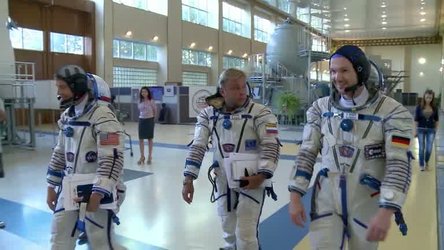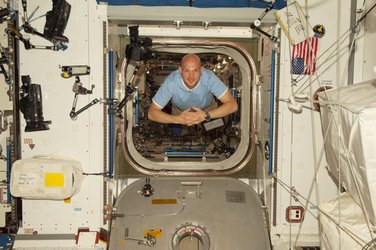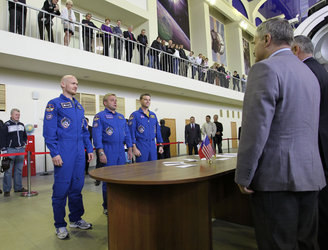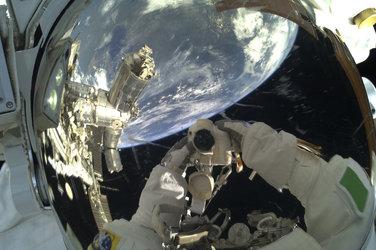Second Space Station mission for Alexander Gerst begins
ESA astronaut Alexander Gerst arrived at the International Space Station today together with NASA astronaut Serena Auñón-Chancellor and Roscosmos commander Sergei Prokopyev, marking the start of Alexander’s Horizons mission.
The trio were launched into space on 6 June at 11:12 GMT (13:12 CEST) in the Soyuz MS-09 spacecraft from Baikonur cosmodrome in Kazakhstan.
After 34 orbits of Earth over two days, the three astronauts aligned their spacecraft with the International Space Station and approached the orbital outpost for docking. The two days were spent in the cramped orbital module of the Soyuz that is no larger than a car. With limited communications and living space the astronauts had time to adapt to weightlessness and reflect on their mission ahead.
The Soyuz MS-09 spacecraft arrived at the 400-tonne International Space Station on 8 June at 13:01 GMT (15:01 CEST) and docked to the Rassvet module. After standard but thorough checks to ensure an airtight connection between the two spaceships the hatches were opened at 15:17 GMT (17:17 CEST) to let Alexander, Serena and Sergei into their home and workplace for the next six months.
During the second part of his mission, Alexander will take over as commander of the International Space Station, only the second European to do so, after Belgian ESA astronaut Frank de Winne in 2009. ESA astronaut Luca Parmitano will be the third European commander next year during his mission in 2019 – a show of trust in European know-how and training for space by the Space Station’s international partners.
Horizons

The mission is called Horizons as a symbol for the unknown and what lies beyond. The mission further cements ESA’s know-how for living and working off-planet. Alexander will be testing ways of operating and working with robots to develop techniques required for further human and robotic exploration of our Solar System such as commanding rovers while orbiting another planet.
Plans to build an international gateway between the Moon and Earth are being discussed this month with Europe supplying key parts such as a habitation module and the service module for NASA’s Orion spacecraft to ferry astronauts, supplies and parts.
An advanced life-support system built in Friedrichshafen, Germany, is set for launch and installation while Alexander is on board. It will allow for humans to live farther away from Earth as it requires less frequent supplies through better recycling of air and water. Next year the Space Station’s communications will get a significant upgrade through a European laser communications system installed outside Columbus that connects to the European Data Relay System.
Research in microgravity
Alexander’s Horizons science programme is packed with European research: he will take part in over 50 experiments to deliver benefits to people on Earth as well as prepare for future space exploration. Many of these experiments will take place in Europe’s Columbus laboratory that is celebrating its 10th anniversary in space this year.

Easier and continued access to humanity’s micro-gravity laboratory for researchers has been secured with the installation of the first European commercial micro-gravity research service ICE Cubes earlier this week. For a fixed fee any research team can run an experiment inside the European space laboratory Columbus.
Preparing the future
All these activities fit within the European exploration strategy that brings new knowledge, innovation and inspiration to European citizens built around international cooperation to bring societies around the world together. ESA is preparing exciting programmes with our international partners to build a low-Earth orbit economy, return humans to the Moon and bring samples back from Mars.
More information
A press conference is planned with Alexander Gerst from the International Space Station on 12 June for European media and will be broadcast live.
Follow Alexander and the Horizons mission on social media via alexandergerst.esa.int


Access the video




























